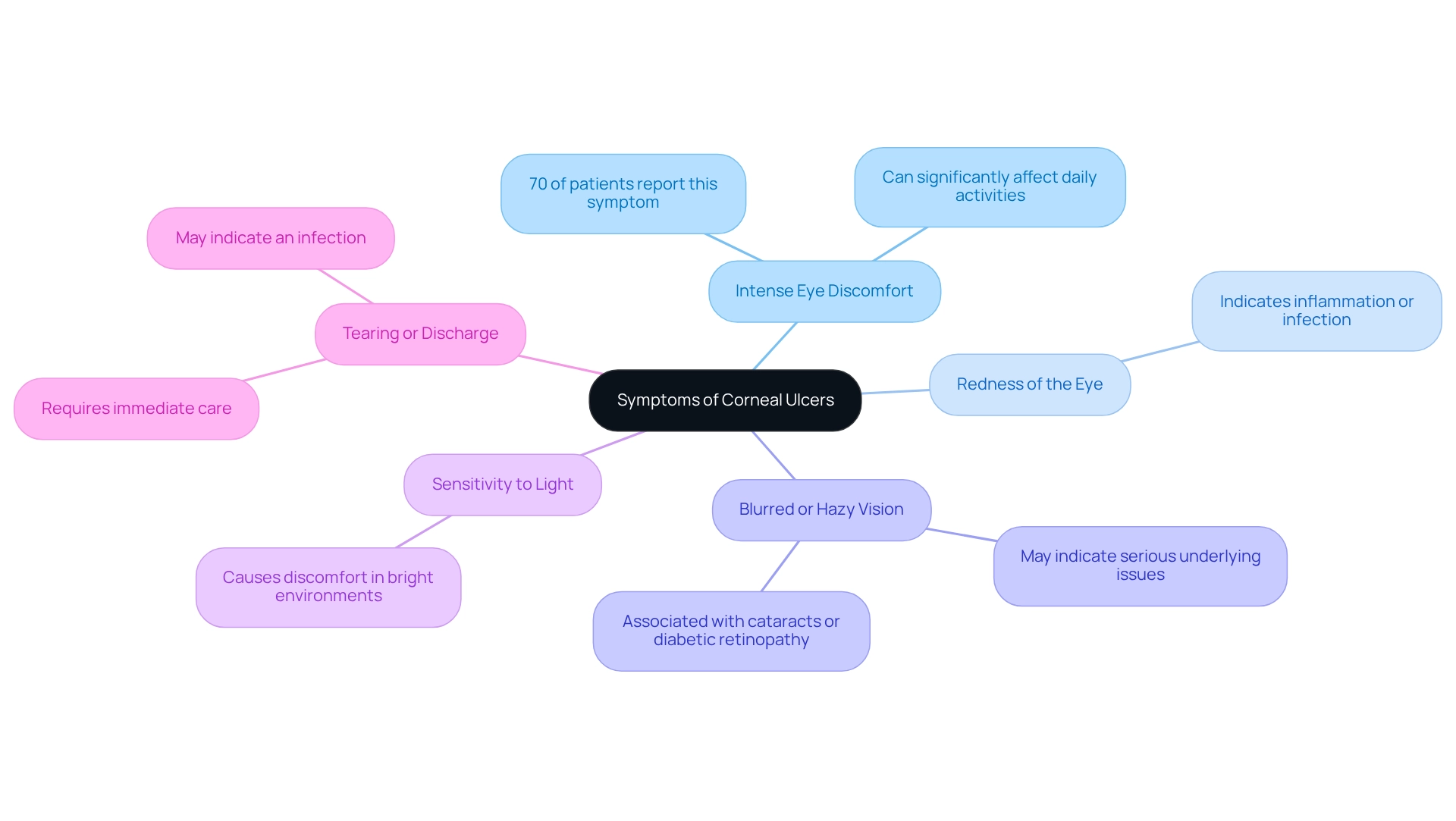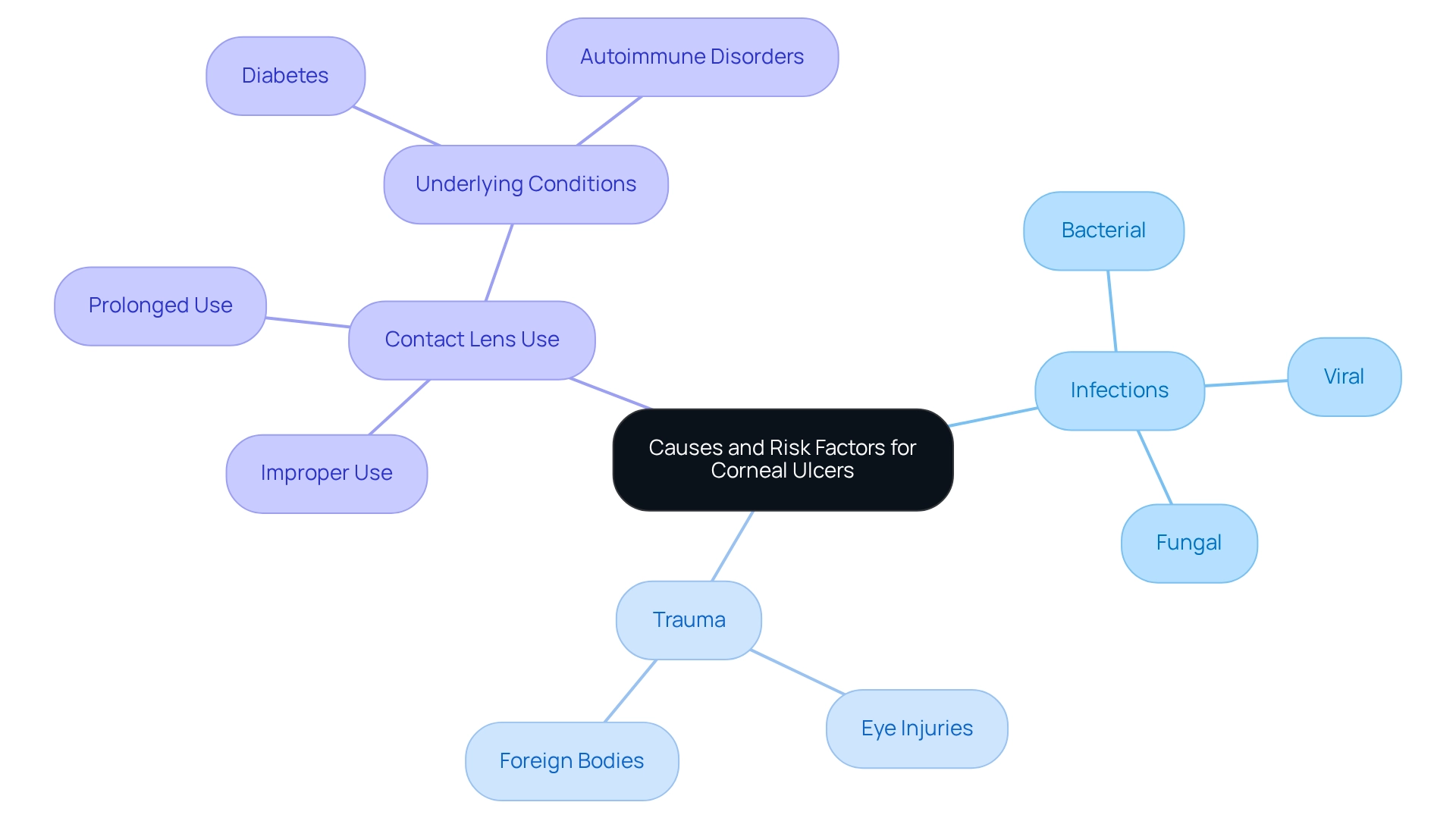Posted by: Northwest Eye in General on May 22, 2025
Overview
This article outlines five essential steps to help you understand and manage corneal ulcer symptoms. We recognize that dealing with such symptoms can be overwhelming, which is why it’s important to identify these symptoms, understand their causes, and explore the available treatment options.
We detail the typical signs of corneal ulcers, the diagnostic procedures necessary for accurate identification, and the various treatment methods available. Each of these elements is crucial for effective management and recovery, and we are here to help you through this process. Remember, it’s common to feel uncertain, but with the right information and support, you can navigate this journey with confidence.
Introduction
In the intricate world of eye health, we understand that corneal ulcers can be a significant concern, posing risks that may lead to lasting vision impairment. These open sores on the cornea can arise from various causes, including:
- Infections
- Injuries
- Underlying health conditions
Symptoms can range from severe pain to blurred vision, and recognizing the early signs is crucial for effective intervention. As awareness grows around the importance of timely diagnosis and treatment, understanding the complexities of corneal ulcers becomes vital for maintaining optimal eye health. This article delves into the:
- Definition
- Symptoms
- Causes
- Diagnostic procedures
- Treatment options
for corneal ulcers, equipping you with the knowledge to safeguard your vision.
Understand Corneal Ulcers: Definition and Importance
An eye sore, or keratitis, is essentially a , which is an , the eye’s clear front surface. We understand that discovering this condition can be concerning. Eye sores, including corneal ulcers, can arise from infections, injuries, or pre-existing eye disorders, and grasping their nature is essential. These lesions, such as a corneal ulcer, present , including the possibility of lasting vision impairment.
, specifically corneal ulcers, are defined as spontaneous chronic epithelial defects of the eye and are particularly troubling. They do not improve within two weeks despite treatment and often require specialized intervention. are crucial to reduce the risks associated with corneal ulcer.
It’s common to feel overwhelmed, but raising awareness about is vital in preserving optimal . Recent research emphasizes that issues stemming from corneal ulcers can lead to serious consequences, underscoring the importance of alertness and prompt medical care.
Thorough assessments are essential to ascertain the size, depth, and origin of , guiding effective treatment approaches. Remember, we are here to help you through this process, ensuring you receive the care you need.
Recognize Symptoms of Corneal Ulcers
Typical signs of eye lesions consist of:
- : We understand that experiencing sharp or piercing pain can be distressing and may significantly affect your daily activities. Statistics show that roughly 70% of patients with eye lesions report this intense discomfort, highlighting the importance of recognizing this symptom.
- : Inflammation can lead to a bloodshot appearance, signaling irritation or infection.
- Blurred or hazy vision: It’s common to feel concerned when your vision is impaired, as this can indicate a serious underlying issue that requires prompt medical attention. may also be associated with conditions such as or diabetic retinopathy, making it essential to seek a professional diagnosis from a .
- (photophobia): Bright lights can cause discomfort, making it challenging to function in well-lit environments.
- : Excessive tearing or the presence of pus may indicate an infection that needs immediate care.
Recognizing these symptoms early is crucial, as timely intervention can lead to better treatment outcomes. If you experience or blurred vision, please seek medical assistance quickly. Significant harm to your eye may require follow-up procedures like a transplant. Real-life patient experiences emphasize the importance of ; early recognition often results in more effective management and recovery. We encourage you to prepare for healthcare visits by noting your symptoms and questions, which can enhance communication with your providers and improve overall satisfaction with your care. Additionally, knowing how to contact your provider for follow-up questions after your visit is essential for your ongoing care.

Identify Causes and Risk Factors for Corneal Ulcers
Eye sores can arise from various factors, and we understand how concerning this can be for you. Each of these factors contributes to the risk of developing this serious eye condition, such as , which can be caused by bacterial, viral, and fungal infections that are common causes of eye sores. Recent findings highlight the significant role these pathogens play in eye health, and it’s common to feel anxious about this.
- Trauma: Injuries to the eye, such as scratches or the presence of foreign bodies, can lead to the formation of sores. Real-world instances show how even slight trauma can develop into if not dealt with quickly.
- Contact Lens Use: The likelihood of rises dramatically with the . This emphasizes the importance for users to follow suggested hygiene practices and replacement timelines to reduce the risk of developing a , particularly for individuals with , as these can adversely affect eye health.
Awareness of these causes and risk factors is essential for prevention. Maintaining appropriate , obtaining , and recognizing the effects of underlying health conditions can greatly lessen the chances of eye infections. Additionally, tailored medical treatment, including , is essential for effective management. We want you to know that in situations where discomfort is linked to , oral pain relievers may be recommended to improve your comfort. Remember, we are here to help you through this process.

Diagnose Corneal Ulcers: Tests and Procedures
Diagnosing a typically involves several important steps that we want you to be aware of:
- : will assess your eye’s overall health, particularly looking for symptoms such as , which can indicate underlying issues.
- : This specialized microscope allows for a detailed visualization of the cornea, helping us identify any abnormalities related to a corneal ulcer.
- : A dye is applied to highlight any damage to the cornea, making corneal ulcers more visible and assisting in the diagnosis of conditions that may cause blurred vision, such as cataracts, diabetic retinopathy, and macular degeneration.
- Cultures: In some cases, we may take samples to identify the specific cause of the corneal ulcer, ensuring that you receive appropriate treatment.
We understand that experiencing symptoms like blurred vision can be concerning. Knowing these diagnostic steps can help alleviate anxiety and prepare you for your visit. If you are experiencing blurred vision or other troubling symptoms, we encourage you to schedule an appointment with for a thorough evaluation. We are here to help you through this process.
Explore Treatment Options for Corneal Ulcers
While treatment for corneal ulcer may be a source of concern, can help ease your worries. Here are some common treatments:
- Topical antibiotics: These are often the first line of defense against bacterial infections. We understand that facing an infection can be daunting, but these medications are designed to help you recover.
- Antiviral or antifungal medications: Depending on the underlying cause, these may be necessary. It’s common to feel uncertain about the right treatment, and will guide you through this process.
- : Over-the-counter pain relievers can help alleviate discomfort. We want you to feel as comfortable as possible during your recovery.
- Surgery: In severe cases, surgical intervention, such as a , may be required. While this may sound intimidating, know that this option is available to provide you with the best chance of healing from a corneal ulcer.
- Follow-up care: are essential to monitor healing from the corneal ulcer and prevent complications. We are here to help you through this process, ensuring that you receive the .
By understanding these , you can engage actively in your recovery journey. Remember, you are not alone, and we are here to support you every step of the way.
Conclusion
Corneal ulcers pose a serious threat to eye health, and we understand how concerning this can be. The potential for complications, including permanent vision loss, makes it crucial to recognize the definition, symptoms, and causes of corneal ulcers for early intervention. Key symptoms such as severe eye pain, redness, blurred vision, and sensitivity to light are critical indicators that should prompt you to seek immediate medical attention. By understanding these signs, you can ensure timely diagnosis and effective treatment, ultimately safeguarding your vision.
The various causes of corneal ulcers highlight the importance of awareness and preventive measures. Infections, trauma, improper contact lens use, and underlying health conditions can all increase the risk of developing ulcers. By practicing good eye care and maintaining regular check-ups, you can significantly reduce your risk and take charge of your eye health.
Diagnostic procedures, including comprehensive eye examinations and specialized tests, play a crucial role in identifying corneal ulcers and guiding treatment. We understand that these processes can be anxiety-inducing, but knowing what to expect can help foster a proactive approach to your eye health. Treatment options range from topical medications to surgical interventions, emphasizing the need for tailored care based on your specific circumstances.
In summary, being vigilant in recognizing symptoms, understanding risk factors, and seeking prompt medical care are essential components in the fight against corneal ulcers. By prioritizing your eye health and staying informed, you can take significant steps toward preserving your vision and preventing the serious consequences associated with this condition. Remember, we are here to help you through this process.
Frequently Asked Questions
What is an eye sore or keratitis?
An eye sore, or keratitis, is essentially a corneal ulcer, which is an open lesion on the cornea, the clear front surface of the eye.
What causes corneal ulcers?
Corneal ulcers can arise from infections, injuries, or pre-existing eye disorders.
Why is it important to understand corneal ulcers?
Understanding corneal ulcers is essential because they present serious dangers, including the possibility of lasting vision impairment.
What are non-healing lesions?
Non-healing lesions, specifically corneal ulcers, are defined as spontaneous chronic epithelial defects of the eye that do not improve within two weeks despite treatment and often require specialized intervention.
What should I do if I suspect I have a corneal ulcer?
Timely identification and swift care are crucial to reduce the risks associated with corneal ulcers, so it is important to seek medical attention promptly.
What are the typical signs of eye lesions?
Typical signs of eye lesions include intense eye discomfort, redness of the eye, blurred or hazy vision, sensitivity to light (photophobia), and tearing or discharge.
How common is intense eye discomfort in patients with eye lesions?
Approximately 70% of patients with eye lesions report experiencing intense eye discomfort.
What should I do if I experience intense eye pain or blurred vision?
If you experience intense eye pain or blurred vision, it is crucial to seek medical assistance quickly, as significant harm to your eye may require follow-up procedures.
How can I prepare for a healthcare visit regarding eye issues?
You can prepare for healthcare visits by noting your symptoms and questions, which can enhance communication with your providers and improve overall satisfaction with your care.
Why is it important to recognize symptoms of corneal ulcers early?
Recognizing symptoms early is crucial because timely intervention can lead to better treatment outcomes and more effective management and recovery.






